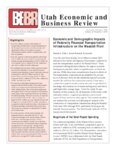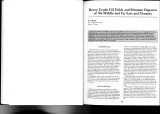TO
| Title | Date | Subject | Description | ||
|---|---|---|---|---|---|
| 1 |
 |
Geology and genesis of the coast range province of California and its hydrocarbon deposits | 1987 | hydrocarbon deposits; tar sand; oil shale | California is along the western borderland of North America where sedimentary deposits accumulated along the eastern Pacific margin. During that time, subduction diastrophism prevailed in the late Mesozoic-early Cenozoic era, and right-lateral strike-slip shear diastrophism prevailed in the middle a... |
| 2 |
 |
The Chinese wax mine: A unique oil-impregnated rock deposit | 1975 | Chinese wax mine; oil-impregnated rock deposit; oil; mineral wax; viscous oil | The Chinese Wax mine in Daniels Canyon, Wasatch County, Utah, is a small deposit of black, viscous, waxy oil emplaced in fractured, brecciated Oquirrh Formation (Pennsylvanian-Permian) on the Strawberry Valley (or Charleston) thrust sheet where the thrust has overriden the west margin of the Uinta B... |
| 3 |
 |
Geology of the Mill Fork Area, Utah | 1972-12 | geology; Mill Fork area; geologic structure; Green River formation | The Mill Fork area comprises about 70 square miles of Cretaceous ( ? ) and Tertiary sediments at the northern end of the Wasatch Plateau in Utah County, Utah. Over 9000 feet of nonmarine sediments are present and belong to the North Horn, Flagstaff, and Green River formations. These sediments record... |
| 4 |
 |
Formation pathways of ethynyl-substituted and cyclopenta-fused polycyclic aromatic hydrocarbons | 2000 | formation pathways of aromatic hydrocarbons; aromatic hydrocarbons; ethynyl-substituted aromatic hydrocarbons; cyclopenta-fused polycyclic aromatic hydrocarbons; PAH; ethynyl-PAH | Two novel classes of polycyclic aromatic hydrocarbons (PAH), those with ethynyl substituents (ethynyl- PAH) and those with externally fused five-membered rings (cyclopenta-fused PAH or CP-PAH), have recently been identified in the products of a variety of fuels and combustion/pyrolysis environments.... |
| 5 |
 |
Petroleum geology of the greater Red Wash Area, Uintah County, Utah | 1965-07 | oil and gas field; sandstone; petroleum geology | The Greater Red Wash area is the largest oil and gas field in the Uinta Basin. The Douglas Creek and Garden Gulch Members of the Green River Formation form a lacustrine delta in the area and yield hydrocarbons from a complex network of discrete sandstones. Each individual sandstone body forms its ow... |
| 6 |
 |
Major tar sand and heavy oil deposits of the United States | 1985-07 | major tar sand; heavy oil deposits; heavy oil resources; tar sand resources; United States | This paper presents a current assessment of U.S. tar sand and heavy oil resources. It is based on an independent appraisal of all tar sand deposits with 100 million barrels in place or more and the construction of a heavy oil reservoir and data base of fields containing more than 20 million barrels ... |
| 7 |
 |
Modeling of asphaltenes: Assessment of sensitivity of 13C SSNMR to molecular structure | 2012 | asphaltenes; heavy oil; liquid hydrocarbon fuels; 13C SSNMR; molecular structure; refinery process | Asphaltenes are an important constituent of many oils and one of the major components in heavy oils sources for liquid hydrocarbon fuels. With light oil sources rapidly depleting, it is necessary to use alternative sources from heavy oil reservoirs. Refining these heavy oil resources presents new ch... |
| 8 |
 |
Surface tar-sand deposits in California | 1987 | surface tar-sand deposits; tar sand; surface tar sand; California; oil seeps; stratigraphy; tar sand deposit structure | Tar sand deposits and oil seeps have been known in California for more than a century and were used in the exploration for many of California's largest oil fields. Sixty deposits visited by this writer yielded 24 deposits totaling 5.27 billion barrels of oil in place and another 36 estimated at 1-2 ... |
| 9 |
 |
Petroliferous lithosomes in the Moenkopi Formation, southern Utah | 1977 | petroleum; stratigraphic study; southeastern and central Utah petroleum; Moenkopi Formation | Recent stratigraphic studies of the Triassic Moenkopi Formation suggest the possibility of important petroleum potential within the unit in southeastern and central Utah. Potential reservoir rocks include shoreline sandstone in the Black Dragon Member, carbonates in the Sinbad Limestone Member, and ... |
| 10 |
 |
Porosity of unconsolidated sand, diatomite, and fractured shale reservoirs, South Belridge and West Cat Canyon oil fields, California | 1987-11-02 | porosity; unconsolidated sand; diatomite; fractured shale reservoirs; South Belridge oil field; West Cat Canyon oil field | Porosity analysis based on conventional core samples, gamma-gamma logs, and borehole gravity (BHG) surveys is presented for a Pleistocene unconsolidated sand reservoir and for Miocene diatomaceous, porcelaneous, and fractured shale reservoirs of the Monterey Formation in the South Belridge oil field... |
| 11 |
 |
The search for a source rock for the giant Tar Sand Triangle accumulation, southeastern Utah | 1999-03 | source rock; giant Tar Sand Triangle; southeastern Utah; oil resource; heavy oil and tar; oil; Tar Sand Triangle accumulation; thermal modeling | A large proportion (about 36%) of the world's oil resource is contained in accumulations of heavy oil or tar. In these large deposits of degraded oil, the oil in place represents only a fraction of what was present at the time of accumulation. In many of these deposits, the source of the oil is unkn... |
| 12 |
 |
California plio-miocene oils: Evidence of early generation | 1987 | plio-miocene oils; California oil; source rocks; commercial generation; LOM; hydrocarbon concentration; oil quality | Early generation of oil from Monterey and equivalent source rocks may well be the primary controlling factor on oil quality in the coastal basins of California. Commercial generation has occurred at reflectance levels as low as 0.3% R0. The wide range of chemical characteristics of these oils is com... |
| 13 |
 |
Oil-impregnated rocks of Utah: USERDA field experiment to recover oil from tar sand | 1976-07 | oil-impregnated rocks; Utah; USERDA; field experiment; recover oil from tar sand; oil recovery | The Laramie Energy Research Center, of the U. S. Energy Research and Development Administration, is equipping a field experiment to test the reverse combustion process for recovery of oil from a tar sand on a 10-acre site on the Northwest Asphalt Ridge deposit near Vernal, Utah. A tar sand section 1... |
| 14 |
 |
Immigrants transform Utah: entering a new era of diversity | 2004-05 | Utah is generally perceived as an extremely homogeneous state whose population can trace its ancestry mostly to northern Europe. Listings for surnames like Hansen, Jensen, and Christensen do fill many pages in local telephone directories throughout the state. According to census counts, the minority... | |
| 15 |
 |
Sulphur isotope abundances in petroleum and associated materials | 1958-11 | sulphur isotope; petroleum; isotopes of sulphur; sulphur isotope abundances; treatment of oil samples | A study has been made of the sulphur isotope ratios for petroleum from many different oil fields in the United States and Canada. The S34/S32 ratio for petroleum varies by about 4.5 per cent as compared with a total spread of about 9 per cent for terrestrial sulphur. The single large oil pools appea... |
| 16 |
 |
Bitumen deposits of northwest Alabama | 1987 | bitumen deposits; northwest Alabama deposits; bituminous rocks | Bituminous rocks of Mississippian age crop out in northwest Alabama within a 113-km (70-mi) long belt. Bitumen deposits have been confirmed by coreholes to be present in the subsurface for a distance of at least 16-24 km (10-15 mi) south of the outcrop. Geochemical analyses indicate the bitumen to b... |
| 17 |
 |
Green River Formation at Raven Ridge, Uintah County, Utah | 1965-07 | Green River formation; Raven Ridge; sandstone beds; shale; limestone; marlstone; oil-bearing strata | Along Raven Ridge in Uintah County, Utah, exposures of the Green River Formation contain a complex sequence of intertonguing beds of sandstone, shale, limestone, and marlstone. These strata are considered to represent deposition in an orderly sequence of environments from the flood plain through the... |
| 18 |
 |
Some possible applications of thermal recovery in Utah | 1965-11 | thermal recovery; applications of thermal recovery; oil reserves; bituminous sandstones; thermal project; bituminous oil sand | The bituminous sandstones of the Rocky Mountain region have significant reserves of oil. Production costs of the reserves must be reduced to be equal to or lower than the cost of crude oil produced by conventional methods. Three Utah deposits alone, Sunny side, Vernal (Asphalt Ridge) and Whiterocks ... |
| 19 |
 |
Heavy-oil deposit, Great Salt Lake, Utah | 1987 | heavy-oil deposit; Great Salt Lake; Neogene basins | The western portion of the Great Salt Lake contains two large Neogene basins, informally called the "North" and "South" basins. These basins are separated by an arch that trends northeast between Carrington Island and Fremont Island. Both basins are filled with Miocene, Pliocene, and Quaternary sedi... |
| 20 |
 |
Utah's tar sand resource: Geology, politics, and economics | 1976 | Utah tar sand; tar sand resource; geology; politics; economics; oil-impregnated rock deposits; oil shale; tar sands | Twelve of fifty deposits of oil-impregnated rock in Utah contain 98 percent of the 26 billion barrels estimated in place. This is about 90 to 95 percent of the total mapped U.S. resource. Several deposits have been and are mined for paving material. Extraction of oil from three deposits is beginning... |
| 21 |
 |
Economic and demographic impacts of federally financed transportation infrastructure on the Wasatch Front | 2004-09 | Over the next three decades, $14.4 billion (constant 2004 dollars) of new transit and highway infrastructure is planned to meet the transportation needs of the Wasatch Front.1 These investments will significantly influence the region's economic development potential, relative competitiveness, and la... | |
| 22 |
 |
Field guide to lacustrine and related nonmarine depositional environments in tertiary rocks, Uinta Basin, Utah | 1976-11 | lacustrine environments; nonmarine depositional environments; tertiary rocks | The lower part of the Tertiary System in the Uinta Basin of northeastern Utah and northwestern Colorado (fig. 1) reflects a series of very complex and variable forms of continental sedimentation in a basin of internal drainage. These complex forms represent the disruption of the Cretaceous depositio... |
| 23 |
 |
Light-oils transformation to heavy oils and asphalts-assessment of the amounts of hydrocarbons removed and the hydrological-geological control of the process | 1987 | light-oils; heavy oils; asphalts; assessment; hydrocarbons; petroleum resources; oil alteration | Heavy oils frequently represent a residue left after removal of saturated and aromatic hydrocarbons by various alteration processes. They are characterized by a high content of asphaltenes and polar compounds and by higher sulfur content than the light oils from which they were derived. In the Dead ... |
| 24 |
 |
Control of geological carbon sequestration in the western United States | 2011-05 | coal; carbon dioxide; electric utilities; carbon sequestration; sequestration; geological sequestration; climate change | In the near future, the use of coal may be legally restricted due to concerns over the effects of its combustion on atmospheric carbon dioxide concentrations. Carbon capture and geologic sequestration offer one method to reduce carbon emissions from coal and other hydrocarbon fuel. While the federal... |
| 25 |
 |
Heavy crude oil fields and bitumen deposits of the Middle and Far East and Oceania | 1987 | heavy crude oil fields; bitumen deposits; Middle and Far East and Oceania; oil resource | A total of 119 heavy-oil fields are located in the Middle and Far East and Oceania, in 19 countries. Of these, 12 have ultimate recoveries of more than 500 million barrels, and nine of more than 1000 million barrels. About 97% of the total resource of 120,000 million barrels is found in the Middle E... |
